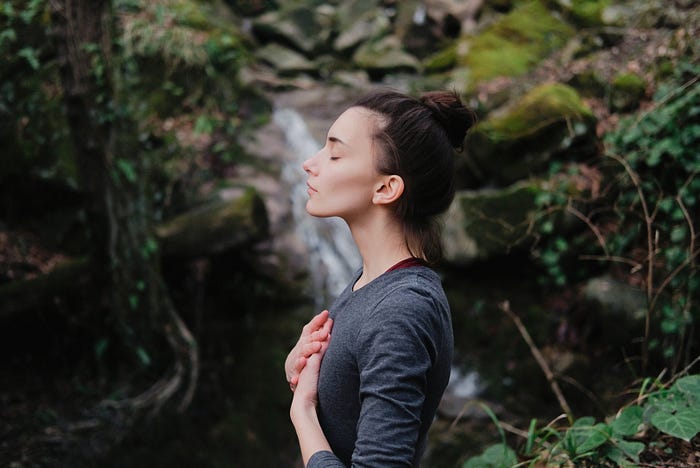The Three Dantians – Finding and Increasing Your Energy
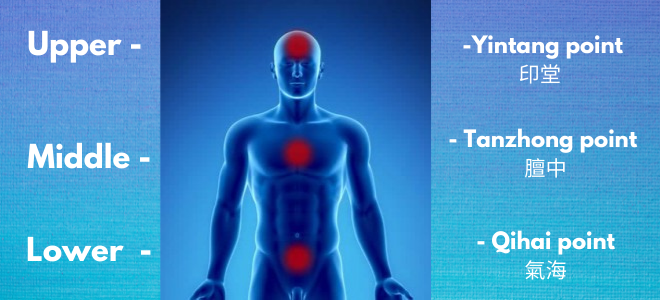
Whether I am teaching tai chi, qigong, or meditation, eventually the conversation turns towards a discussion of how to find, focus on, feel, and build energy in the three dantians. New students want a roadmap, or at least an idea of what to focus on and how their practice is going to improve their health. More experienced practitioners are typically excited about what they are feeling and want to bring their energy, health, or meditation to the next level.
The three dantians are energy centers in the body described by Chinese medicine as cumulation points (vessels) in the head, chest, and abdomen. Meditation, tai chi, and breathing techniques can be used to build energy in the body to improve health. This energy can be felt in these three areas.
The good news is that practitioners at any level can make greater progress by understanding a bit more about the three dantians because it makes the whole process of meditation and building internal strength less mystical. We just need to learn a little history, know where they are located, and why they are important to our practice.
Pro-tip: Learning about internal energy and the use of it during movements and meditation takes continual learning on the topic over a period of time. Check out books and resources on Amazon that help expand your understanding and knowledge.
What is the Meaning of the Word Dantian?

Our one word – Dantian is the combination of two Chinese symbols. Understanding what Dantian means in Chinese also helps us understand the concept as a whole. Dan (pronounced “Don”) is the character for Cinnabar which is prized element that used in many Chinese medicines and red dye for tattoos and art. It is most often translated as “elixir” to convey the idea that is a powerful healing substance.
Tian (pronounced “Tea-en”) means field. This gives us the idea that it is an open area that is fertile and capable of new growth. What you should also get from this half of the word is that it conveys the idea of cultivation. Building energy in this “elixir field” takes time, just like growing plants does. Secondly, the energy starts small just like a seed eventually turns into a stalk and then a full plant or tree.
If you are looking for dantien – dantian – dan tian – dan tien you are still in the right place. The most common spelling is dantian. Read more about the reasons behind the differences in pronunciation here: Tai chi 101 : Is it Tai Chi, Taiji, taichi, or T’ai Chi Chuan?
What is the Dantian?
The dantian is an energy center. It is a place in the body where energy is stored and built and is a major point of focus during meditation for exercises (e.g. qigong, yoga) designed to improve or increase someone’s energy. In total there are three dan tians, but when people talk about “the” dan tian they are usually talking about the lower dan tian because it is the originating source of the energy that travels to the other two. For many martial arts, their sole focus is the lower dan tian because it promotes balance and power for striking. Their art or their interest doesn’t include meditation or internal development so the one, lower dan tian is all they are concerned with.
All major Eastern practices have focuses on the dantian for different purposes and call them a different name. Japanese martial arts call the lower dantian the Hara for example. Meditation traditions such as Daoism and Buddhism focus on the dantians while altering their breathing to reduce heightened thinking and emotions. Yoga and Ayurvedic traditions also have centers where energy is stored. While the Indian chakras and Chinese dantian are fundamentally different, they are both energy centers that can be used during a practice to increase, reduce, or improve an energy.
Is the Dantian Real and is the Energy Real?
I am intentionally avoiding the many foreign words used to describe energy because I feel it complicates things and results in a lot fewer people improving their practice and life because they get caught up in theoretical or esoteric arguments. Chi, Qi, or Prana are all energy. There are also different versions of each of those energies. But here is what you need to know:
You know when you have low energy and very low energy like when you are sick. You know when you have high energy like when you drink caffeine, are enjoying a fun event, or are motivated by your work. You also can admit that there are times in life when you have more energy like when we are young or in good shape. Additionally, you can detect “cleaner” energy when you are around happy people or are not forced to make decisions that go against your ethics.
Think of meditation, yoga, tai chi, or qigong as a way to clean up the energy you have, get more of the good stuff, and get rid of the dirty stuff. What is the outcome? Your body can use the energy to heal. You are more enjoyable to be around and enjoy life more. You are more accepting of things when they don’t go how you want and are less affected by negative situations and negative people. Learning about the three dantians sets this process in motion.
What Are the Three Dantians?
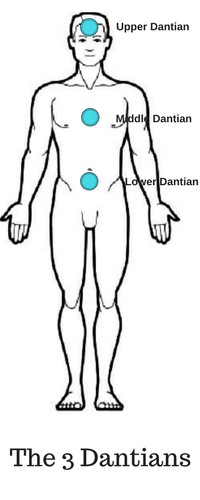
Let’s begin by simplifying what the three dantians are and how they work together. Then we focus on each one to get the whole pictured.
Think of the three dantians as energy centers that are stacked on top of each other. Each dantian has a different energy that serves a different purpose. They are connected as a single concept because through our practice we build energy in the lower dantian first. This gives us an abundance of energy and vitality in the same way that saving extra money gives us the ability to invest in new things rather than just scraping by day-to-day. If your energy is low, that’s kind of what you are doing. Your body has to divert your resources to just getting by. So what happens when you catch a cold or get injured? Everything has to stop because you don’t have enough energy to make it through the day-to-day and also heal.
The second of the three dantians is the middle dantian. After building up the energy in your lower dantian, you have a surplus to expand up and feed your health. It is believed that the middle dantian supports our organs, blood, and respiration.
Once our health is taken care of, you have a surplus of energy to positively impact your thinking and emotions. The third or the three dantians is the upper dantian. I believe that there is a lot of confusion out there about the upper dantian and I think that it is probably because most people have not fully developed the lower two dantians so when they talk about it they might be speculating. Also, the upper dantian is very different from the lower two. Whereas the lower two dantians are characterized by what we are building and what we are doing, the upper dantian is all about emptiness and what is missing. Here’s what I mean, clear, enjoyable, productive thinking is the outcome of not being overrun by emotions, not having “monkey mind” and runaway thoughts, and having a ton of fresh oxygen in the blood. A lot of people see being able to focus or concentrate as a learned skill or special ability. In truth, focus is what is left when all the other nonsense goes away.
Yes we could get all mystical thinking about this stuff but at a basic level it just makes sense. If you have enough energy and health your body will repair itself. Once the body has its basic needs met, you have access to really clear thinking, epiphanies, new business ideas, and ways to “respond to opportunities” rather than “reacting to problems.” Pretty cool right?
3 Things to Know So You Can Locate You Dantians
I really want to jump up and say “Hey! The 3 dantians are right here!!! But, I would be doing you a disservice. That conversation is really difficult if we enter into it thinking that the dantian is a thing, like and organ that we could see on an X-ray. We would also be wrong to think that the dantian is a just a space, like air that is trapped between organs. Instead, think about an injury that you may have had. Like a deep bruising or pain from a twisted joint. The pain from the injury radiates out and can be felt in bone, muscle, tendons, and the skin. If I were to ask you where you are hurt, you would describe “where” the pain is radiating to. However, you probably feel pain in tissue that is totally fine, right? Because the next day it is smaller, and then smaller the day after that.
The dantians encompass areas of the torso, chest, and head that includes all the surrounding tissue. It can be felt and the sensation of each dantian can be made stronger through breathing and meditation.
The Physical Dantian
A physiological view of the dantian is limited because it doesn’t jive with how our culture defines physiology. It cannot be cut into. It cannot be located due to its relationship to adjacent body parts. However, it is felt due to its central relationship to the entire body.
The Metaphorical Dantian
It is solid and yet it is spacious. A room is no-thing but is defined by things (walls, ceiling, floor) around it. Without those pieces, a room doesn’t exist. I love this picture of the pelvic musculature because it looks like the sinks that were made in a factory near my house as a kid. With the guts removed, you can imagine that the lower dantian is the middle space, equal-distant from the walls of the pelvis.
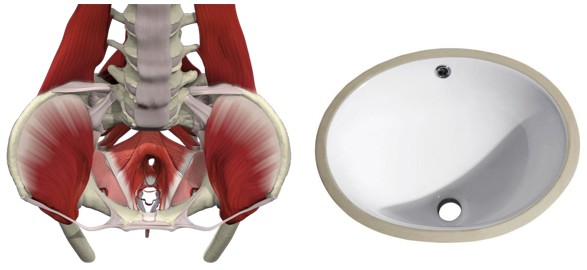
The Sense-ational Dantian
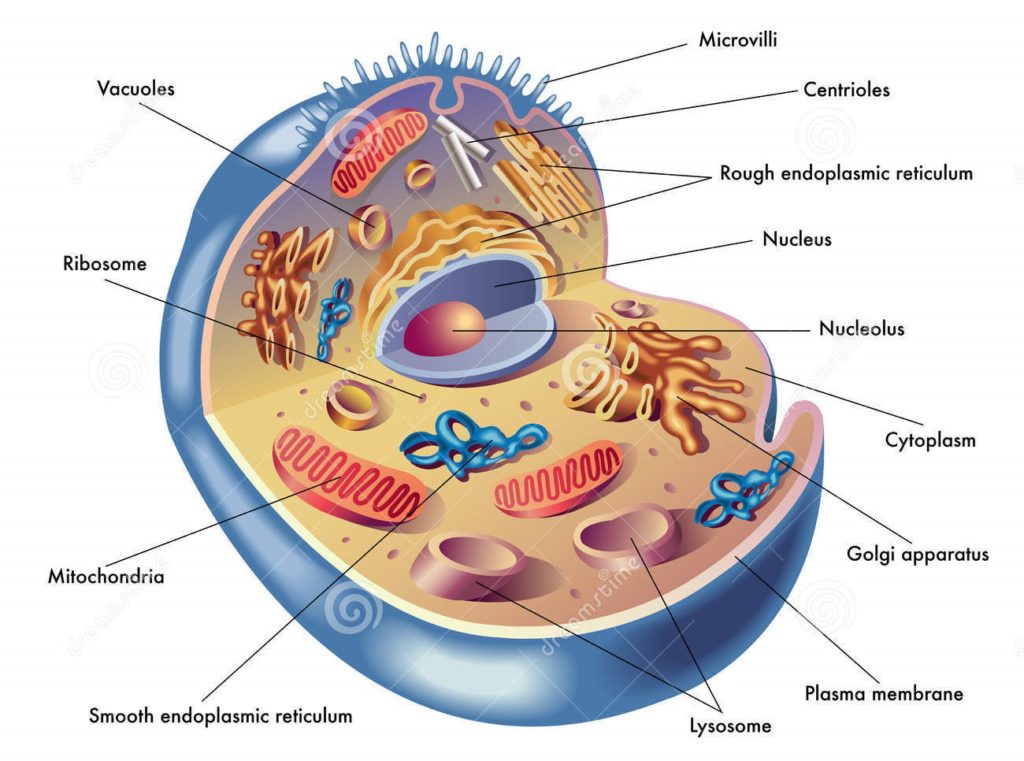
The dantian can feel like it grows and shrinks or even changes temperature. Yet, I don’t know of any research that shows that the dantian is connected to the endocrine system or is cellular. My thinking on this is that my body is trying to explain these sensations through the only other experiences that I have.
Where Are the Three Dantians?
So as we begin to talk about where the three dantians are, keep in mind that we are talking about spaces, fields, that are central in the body. They can be as small as a marble and as large as a tennis ball depending on how much effort you have put into cultivating them. The sensation of the dantian also radiates out, giving us the sense that it larger than the central area it is located in.
Finding the Lower Dantian
The lower dantian (Xià Dāntián – 下丹田) is in the exact center of the body. It is located two inches below the belly button and is centered in the middle of the abdominal cavity. The energy of the lower dantian is called Jing which means primordial or original energy. Think of it is the energy that gave and gives us life. When we use it up, we pass away! So the process of aging is the using of and eventually running out of Jing. The good news is that 1) Jing can be replenished through practices like qigong, yoga, tai chi, and meditation and 2) we can also use less Jing as we live by staying healthy and reducing stress. Extra or strong Jing is like an investment that starts to earn interest. The interest in this case travels up to the middle dantian to improve our health.
The Middle Dantian Might Not Be Located Where You Think
The middle dantian (Zhōng Dāntián – 中丹田) is located directly behind the sternum in the center of the torso. In my experience the middle dantian feels like two bowls with their bottoms pressed together. The bottom bowl is like a bell jar over the diaphragm and organs and the top bowl is filled with the lungs. When I meditate on the middle dantian and inhale, the sensation travels up into my chest and down to connect with my belly simultaneously. When the sensation is strong, it actually pulls me up into a slightly better poster.
I disagree with a lot of information that is out there about where the middle dantian is located. Many people believe the middle dantian is located at the heart. From a tai chi and qigong perspective this doesn’t make a lot of sense. In tai chi we work diligently to reduce the pressure and intensity on the heart with hard exhales when we are issuing force like when we punch and kick. In qi gong, we are actively trying to relax our muscles and slow our breathing. So we can’t focus on the heart organ intensely and simultaneously reduce pressure and temperature. We can however focus below the heart on the middle dantian to benefit all of the organs above and below.
The energy of the middle dantian is called Qi. It is best described as “vital force energy” and is the same energy that we get from food, air, and what we drink. Let’s step away from the esoteric for a second and think about this. If we eat and drink in a health way, our organs and body are more healthy. If we eat poorly, our body has to extract what it can from the food just to keep us going and very little is left for extra activities or repairing tissue.
If we practice or meditate on the lower dantian regularly, we have extra funds that are transferred up to be converted into Qi to nourish all the organs in our torso. For many of us the health benefits are the main reason we are doing tai chi, yoga, or meditation and building of clean, usable Qi is already a success. However, when our physical needs are met and we are “healthy,” we now have the bandwidth to positively affect our life, those around us, and do some good in this world. Good can mean helping others but it can also mean doing well at your job to support your family as well as serving others. This is where the upper dantian and the energy Shen come in.
How to Find The Upper Dantian
The upper dantian (Shàng Dāntián, 上丹田) is located in the center of the head, directly behind the point centered between the eyebrows. It is most often associated with the pineal gland. It is important to note that it IS NOT the point between the eyebrows, often referred to as the third eye. This is a big mistake that I made early on in my training that stopped my development for several years. I thought the upper dantian was the third eye and that’s all I concentrated on. The truth is that we do need to concentrate on that point as part of our practice initially until we develop a feeling like it is open. However, if we stay focused on the forehead we can’t progress
The energy associated with the upper dantian is called Shen. Shen is best translated as spirit, but is described in more understandable terms as; awareness, intention, intellect, decision-making, planning, and memory. As we move from the lower to upper dantian, the energy becomes more and more subtle and harder to sense or feel. This is another reason that so much emphasis is put on the lower dantian so Shen can be felt strongly when your progress gets you here.
In my experience, the upper dantian feels like a pressure both in a physiological and psychological sense. Physically the pressure expands in a really pleasant way, pushing out through the third eye and up thorough the very top of your head. Mentally it feels like pressure that creates a fullness so that thoughts are slow or not jumbled and everything comes to a standstill in the same way that a full jug doesn’t slosh around.
So as a recap, energy is built in the abdomen through meditation, concentration, and breathing. This energy (Jing) fuels us and when there is enough extra it (Qi) moves up through the torso and heals or tonifies our organs making us more healthy. When our body is able to sustain our health, the excess energy is distilled into a more pure substance (Shen) which travels up to the head and enables clear and calm thinking. After that is established we can begin to experience the absence of thought, stress, and chaotic thinking which is know as Wu Ji.
How Do We Activate the Lower Dantian and Build Energy in Our Body?
So many traditions have a system of movements or meditation to build energy in the lower dantian and move the energy up through all three dantians. What I am hoping that you will get from this information is an understanding of how your system or practice might progress and what you should be focusing on. That being said, there are some practical steps that can help us activate the lower dantian and build energy in our body.
- Sit or stand and focus on your lower abdomen
- Place both palms on your abdomen, two inches below the belly button
- Breathe deeply but naturally to fill the entire pelvis area
- Pay attention to any subtle changes in that area. You may feel warmth, pulsations, tingling, or a fullness
- filling the entire pelvis
The two important principles that begin cleaning and building energy are posture and breath. We 1) maintain a good posture and 2) regulate our breathing. Then we 3) coordinate our movements with our breath and at an advanced level 4) move our energy internally with our intention. No practice for discovering and building energy in your dantians is the centuries old microcosmic orbit meditation. It is a very tangible way to make progress.
How can I learn to find, use, and build energy in my dantian?
When people are new or newish to this concept, there are really only one or two ways to really sense the dantian and begin to build energy up and that’s qigong or some sitting meditations. This is incredibly difficult for people who already have experience meditating or doing a moving art. For example, too much is going on in yoga and tai chi for a person to get the postures right and focus on energy in the dantian. Can you move from and be aware of the dantian during these activities? Certainly. But can you build awareness of the dantian and build energy there? That would be tough.
Most styles of sitting meditation outside of the Taoist camps also make this difficult because you are often focusing on the opposite; letting go, relaxation, etc. Totally fine but qigong and meditative sets like the Microcosmic Orbit specifically build energy to the level you can feel it. Don’t take this the wrong way, and think you shouldn’t do those practices. You just need to build the energy up, wrap your mind around the process, and then it is easy to incorporate back into your moving or sitting practice.
The one qigong set that I love that has enabled practitioners to learn qigong on their own is the Good Morning Good Evening Qi Gong Set. You can read about my experience with it here.

